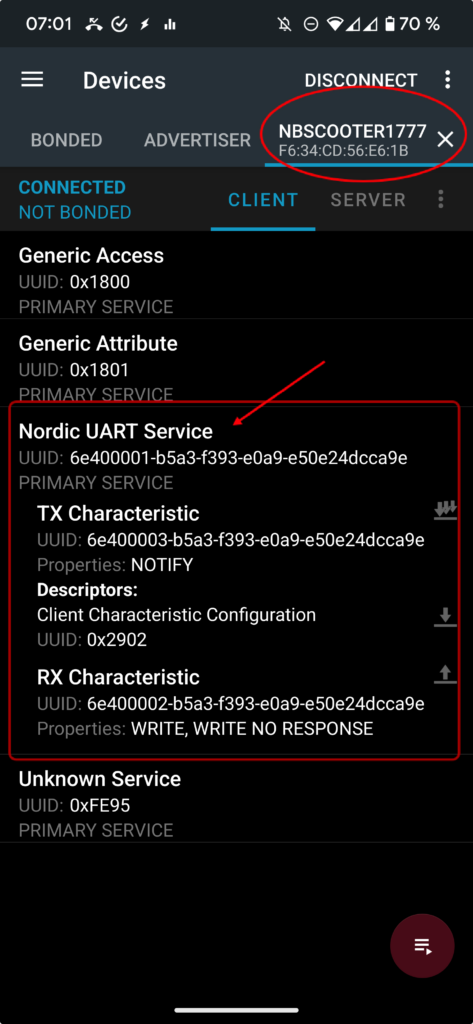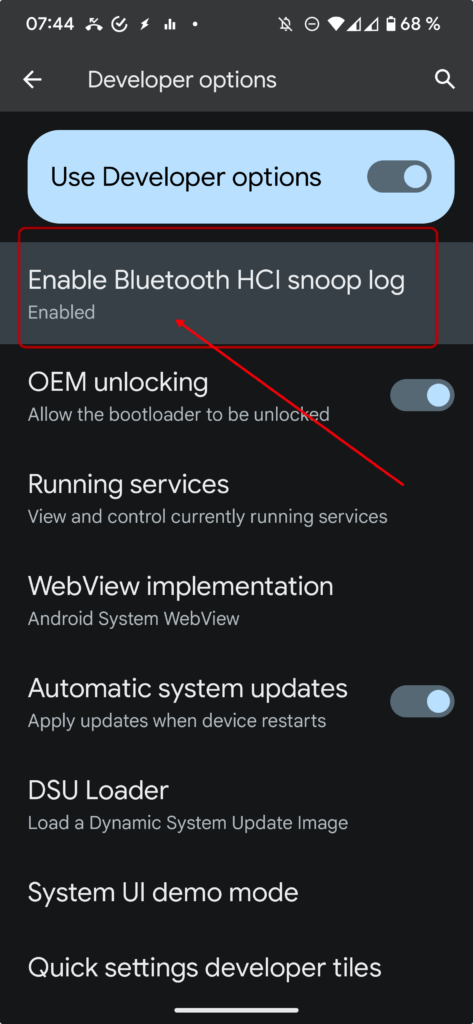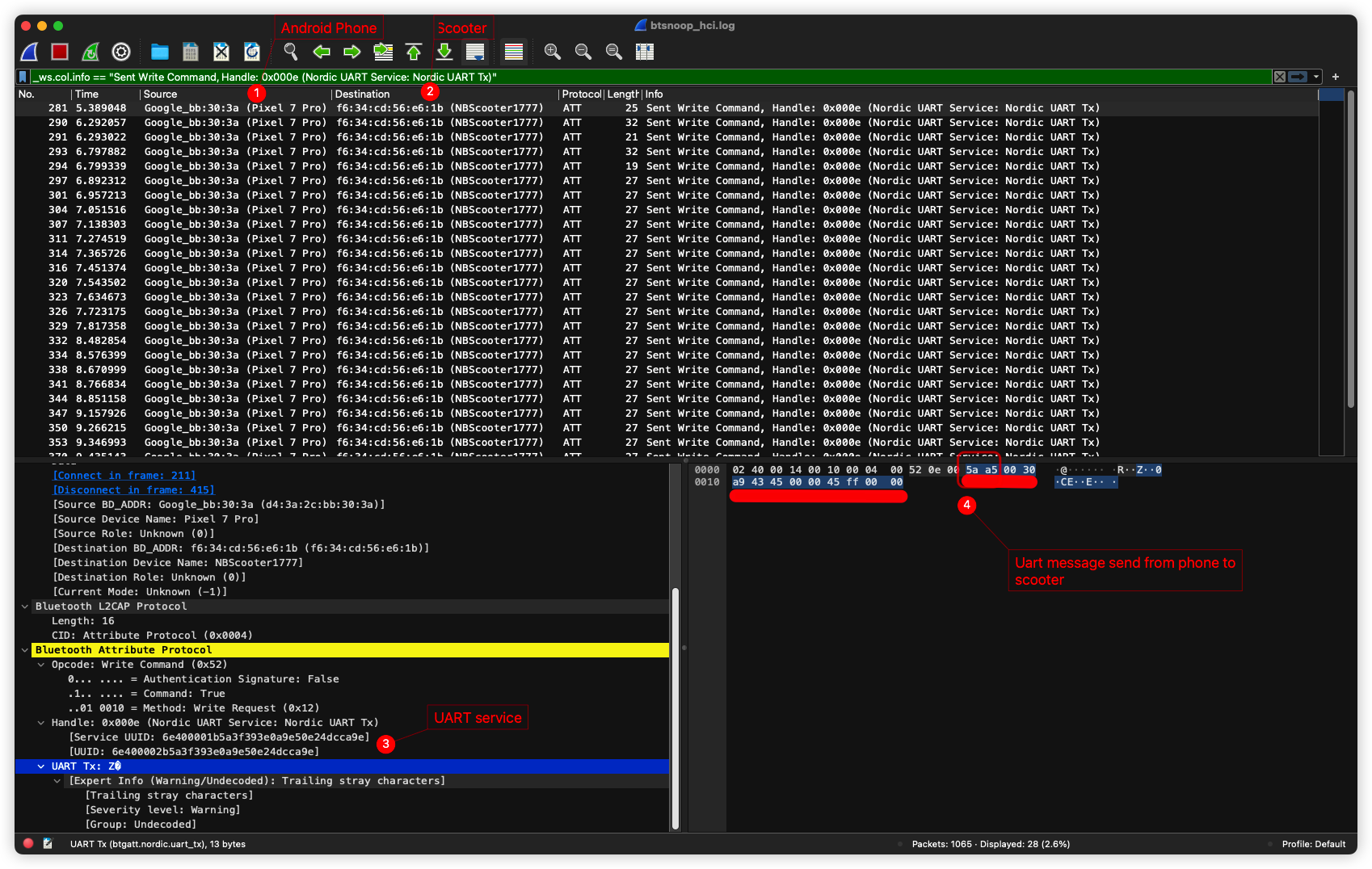
Source code on Github: https://github.com/irmo-de/9UnBot/
Introduction
When I began using my eScooter, I was dissatisfied with the included app. This app connects to the scooter via Bluetooth Low Energy (LE), allowing users to change settings, display speed, lock/unlock the scooter, and more.
However, it lacks automation features, such as auto-connecting when the scooter is within range. Such functionality would be highly beneficial, particularly for using the lock feature or implementing custom commands with a customized drive firmware.
Let’s explore Bluetooth on the eScooter and its associated protocol
A great starting point is a document released by a group known as ‘Scooter Hacking’. It describes the principles of the UART communication protocol between the Bluetooth module and the scooter’s hardware.
https://wiki.scooterhacking.org/doku.php?id=nbdocs

Using the nRF Connect tool, we observe a UART interface. While this might seem straightforward at first glance, as we delve deeper, it becomes apparent that the process is more complex than it initially appears.

Let’s take a closer look at what we can observe in the screenshot. In the top right corner, we see the connected device, which in my case is ‘NBSCOOTER1777’. More interestingly, we observe the services, including the Nordic UART service. We’ll note down the UUIDs for later reference.
| Bluetooth Service | UUID |
|---|---|
| UART Service | 6e400001-b5a3-f393-e0a9-e50e24dcca9e |
| TX Characteristic | 6e400002-b5a3-f393-e0a9-e50e24dcca9e |
| RX Characteristic | 6e400003-b5a3-f393-e0a9-e50e24dcca9e |
public static final UUID TX_CHARACTERISTIC_UUID = UUID.fromString("6e400002-b5a3-f393-e0a9-e50e24dcca9e");
public static final UUID RX_CHARACTERISTIC_UUID = UUID.fromString("6e400003-b5a3-f393-e0a9-e50e24dcca9e");
public static final UUID UART_SERVICE_UUID = UUID.fromString("6e400001-b5a3-f393-e0a9-e50e24dcca9e");
Wireshark for Bluetooth Network Protocol Analysis
To understand what is transmitted over the Bluetooth UART interface, we can use Wireshark. But how do we capture Bluetooth messages? With an Android phone, this task is straightforward. Simply enable Bluetooth HCI snoop in the developer options. This action logs the complete Bluetooth traffic between the phone and any connected device to a text file, which can then be analyzed with Wireshark.

Moving forward, the next step is to download the Bluetooth capture file from the phone and open it in Wireshark. Within Wireshark, we are able to view the traffic between the phone (1) and the scooter (2), particularly when the official Ninebot app is in use. By applying a filter for ‘send commands’, we can then proceed to analyze the UART messages.

Let’s revisit the scooter hacking document for further insights.

In our analysis, we notice that messages begin with the frame header 0x5A 0xA5, which is also visible in the Bluetooth log. However, the subsequent data does not align, suggesting a difference in the UART communication. A quick search on Google reveals an unpleasant surprise. In their more recent Bluetooth communication versions, Ninebot and Xiaomi (both sharing the same technology platform) have introduced encryption. This complicates our task significantly. Fortunately, there are two GitHub projects that have come to our rescue. These projects have successfully reverse-engineered the encryption, offering a potential solution to our challenge.

https://github.com/scooterhacking/NinebotCrypto
NinebotCrypto, a library reverse-engineered from Ninebot/Xiaomi’s first crypto protocol, offers encryption for legacy Ninebot packets and supports a range of BLE versions across different scooter models. The guide details the process of implementing chained crypto in apps, stressing the importance of understanding the legacy Ninebot-Xiaomi protocol. Key steps include importing the library, managing encryption and decryption of scooter communications, and a thorough explanation of the pairing process with specific commands and responses for seamless integration.
At first glance, this might seem a bit complex, given that it requires implementing the entire communication process. This led me to opt for the second GitHub project initially. As we’ll discover later, this turned out to be a rather time-consuming mistake.
https://github.com/dnandha/miauth
The Xiaomi Mi / Nb BLE authentication project addresses the challenges posed by recent protocol changes in Xiaomi BLE communication, aiming to revive apps that lost compatibility. It offers detailed documentation of the authentication process and provides both Python and Java libraries for easy implementation.
The second GitHub project showcases a Python library that’s ideally suited for Linux environments, making it particularly convenient for use on a Raspberry Pi 4, which comes with a built-in Bluetooth module. Once the necessary Bluetooth libraries are installed, it’s all set to go. Let’s now take a closer look at the output this setup yields:
miauth -n -v F6:34:CD:56:E6:1B -c 5AA5023D20037A0100
-n for ninebot
-v for verbose output
Here is the result:
Namespace(mac='F6:34:CD:56:E6:1B', m365=False, nb=True, command='5AA5023D20037A0100', serial=False, fwver=False, verbose=True, register=False, register_did=None, token_file='./mi_token') Using Nb Connecting enabling notifications for: 6e400003-b5a3-f393-e0a9-e50e24dcca9e enabling notifications for: None Authenticating Current state: State.CON b'Z\xa5\x00=![\x00' bytearray(b'Z\xa5\x003\xa9CE\x00\x00F\xff\x00\x00') Sending message: 5a a5 00 33 a9 43 45 00 00 46 ff 00 00 Current state: State.CON b'Z\xa5\x00=![\x00' bytearray(b'Z\xa5\x003\xa9CE\x00\x00F\xff\x00\x00') Sending message: 5a a5 00 33 a9 43 45 00 00 46 ff 00 00 Received message: 5a a5 1e 2f b5 43 44 44 ab b5 9d d7 21 61 20 88 5d 89 9c a0 Decoded message: 5a a5 1e 21 3d 5b 01 7d a2 78 b7 97 3e 26 Received message: 5a a5 1e 2f b5 43 44 44 ab b5 9d d7 21 61 20 88 5d 89 9c a0 da 60 7f 77 3d 8a 6f 18 2d 75 93 96 b0 74 32 39 bf 00 00 3b Decoded message: 5a a5 1e 21 3d 5b 01 7d a2 78 b7 97 3e 26 86 2c ae cc 99 ae 52 78 3a 4e 34 47 45 58 32 32 35 32 43 31 Received message: 5a a5 1e 2f b5 43 44 44 ab b5 9d d7 21 61 20 88 5d 89 9c a0 da 60 7f 77 3d 8a 6f 18 2d 75 93 96 b0 74 32 39 bf 00 00 3b f4 00 00 Decoded message: 5a a5 1e 21 3d 5b 01 7d a2 78 b7 97 3e 26 86 2c ae cc 99 ae 52 78 3a 4e 34 47 45 58 32 32 35 32 43 31 37 37 37 Got cmd: 5a a5 1e 21 3d 5b 01 > BLE Key: 7d a2 78 b7 97 3e 26 86 2c ae cc 99 ae 52 78 3a > Serial: N4GEX2252C1777 Setting ble data/key in crypto Current state: State.PING Sending message: 5a a5 10 fe 42 1f 5a cf 31 5a 3f 72 0b 5e 14 51 23 cd 54 c2 42 36 4f 00 00 27 f8 00 00 Current state: State.PING Sending message: 5a a5 10 fe 42 1f 5a cf 31 5a 3f 72 0b 5e 14 51 23 cd 54 c2 42 36 4f 00 00 27 f8 00 00 Received message: 5a a5 00 2c 38 ac e5 9b 04 d5 bd 00 02 Decoded message: 5a a5 00 21 3d 5c 00 Got cmd: 5a a5 00 21 3d 5c 00 Current state: State.PRE >> Please press the POWER button on the device Sending message: 5a a5 0e 7f 1f 6b 20 b8 42 b9 b5 6b 7f 8e 6b bd 4e d3 ef 67 69 7c f5 9b ac 00 03 Received message: 5a a5 00 63 03 6a 20 9c f9 fe 2c 00 03 Decoded message: 5a a5 00 21 3d 5c 00 Got cmd: 5a a5 00 21 3d 5c 00 Current state: State.PRE >> Please press the POWER button on the device Sending message: 5a a5 0e 95 6c 61 62 bf 0a 8b 83 7e b0 d3 a4 9e 95 f1 0d 4b 91 99 59 b1 79 00 04 Received message: 5a a5 00 89 70 61 63 cf fa b2 39 00 04 Decoded message: 5a a5 00 21 3d 5d 01 Got cmd: 5a a5 00 21 3d 5d 01 Nb authentication successful! Sending message: 5a a5 02 b7 46 18 0b 74 91 70 fc de b6 00 05 Received message: 5a a5 00 ab 5b 46 70 be 63 67 c9 00 05 Decoded message: 5a a5 00 21 3d 5d 01 Got cmd: 5a a5 00 21 3d 5d 01 Nb authentication successful! UART reply: 5a a5 00 ab 5b 46 70 be 63 67 c9 00 05 Disconnecting
After successfully sending a custom python command, I initially believed integrating the Java library from the same Github into my project would be straightforward. However, this turned out to be a misconception. The integration of the library for Bluetooth communication revealed that the Ninebot implementation was incomplete. Despite my efforts to add the missing code, I ultimately found it too time-consuming to replicate what was lacking. Fortunately, we have another GitHub project which contains the library for encryption and decryption, meaning I still needed to implement the authentication communication myself.
Before delving into the output, let’s first examine the crypto implementation from NinebotCrypto. It utilizes cryptographic methods for secure data transmission, incorporating SHA-1 for key generation, AES for encryption, and CRC for error checking. However, its use of ECB mode in AES and SHA-1 may raise security concerns, given the existence of more secure alternatives.
Security Considerations:
- Use of SHA-1: Although SHA-1 is perceived as weak in certain applications due to collision attack vulnerabilities, its role here appears limited to key generation, not security hashing.
- AES in ECB Mode: While AES is robust, ECB mode’s vulnerability lies in its lack of serious message confidentiality, especially evident through identical plaintext blocks producing identical ciphertext blocks.
- Absence of IV in AES: The lack of an Initialization Vector (IV) in ECB mode is a significant shortfall, especially since modes like CBC or GCM typically use an IV for enhanced security.
One can only speculate about the developers’ choice of ECB mode. My best guess includes:
- Simplicity in Implementation: ECB’s straightforward block-by-block processing makes it easier to implement than more complex modes like CBC or GCM.
- Efficiency for Small Data: ECB is efficient for small data blocks, especially when the data size matches or is less than the cipher’s block size (16 bytes for AES).
- Low Resource Requirement: ECB’s simplicity translates into lower computational resource demands, making it suitable for systems with constrained processing capabilities.
- No Error Propagation: ECB encrypts each block independently, preventing transmission errors in one block from affecting others, unlike modes like CBC where a single error can corrupt subsequent blocks.”
Since the project primarily focuses on the encryption aspect, I found myself tasked with implementing the Bluetooth UART communication from scratch. For this, I opted to use rxandroidble2, which significantly eases the handling of Bluetooth Low Energy (BLE) communications. The complete code for this implementation is available on my GitHub.
private void establishConnection() {
connectionDisposable = rxBleDevice.establishConnection(false)
.timeout(50000, TimeUnit.SECONDS) // Set timeout for 50 seconds
.flatMap(rxBleConnection -> {
// Store the connection
this.rxBleConnection = rxBleConnection;
// Start service discovery and convert Single to Observable
return rxBleConnection.discoverServices().toObservable();
})
.flatMap(rxBleDeviceServices -> {
// Check if the UART service is available on the device
if (rxBleDeviceServices.getService(UART_SERVICE_UUID) != null) {
// UART service is available, continue with setting up notification
return Observable.just(this.rxBleConnection);
} else {
// UART service is not available, complete the observable with an error
return Observable.error(new IllegalStateException("UART service not found"));
}
})
.subscribe(
connection -> {
// At this point, we know that the UART service is available
setupNotification();
},
throwable -> {
// Handle errors
if (throwable instanceof TimeoutException) {
Log.e("nb_ble", "Failed to connect to BLE device within 5 seconds.");
} else {
Log.e("nb_ble", "Error establishing BLE connection: " + throwable.getMessage());
}
}
);
// Optionally store connectionDisposable for later disposal if needed
}
private void setupNotification() {
if (rxBleConnection != null) {
Log.i("nb_ble", "Setup notification receiver... ");
rxBleConnection.setupNotification(RX_CHARACTERISTIC_UUID)
.flatMap(notificationObservable -> notificationObservable)
.subscribe(
bytes -> {
Log.i("nb_ble", "Received notification: " + bytesToHex(bytes));
notificationQueue.offer(bytes);
},
throwable -> {
Log.e("nb_ble", "Error in setupNotification: " + throwable.getMessage(), throwable);
}
);
}
}
Key insights that would have been beneficial to know beforehand, and that took some time to figure out, include:
- Messages from the Ninebot are divided into chunks of 20 bytes.
- When sending messages longer than 20 bytes, it’s necessary to break them down into smaller chunks.
- The library conveniently incorporates the CRC checksum
Here is the needed bytecode to be send to the scooter. For details have a look at the Github Code for this project.
| Command | Byte Code |
|---|---|
| InitMessage | 5AA5003E215B00 |
| pingMessage | 5AA5103E215C00 |
| pairMessage | 5AA50E3E215D00 |
| unlockFirmware | 5AA5023D20037A0000 |
| lockFirmware | 5AA5023D20037A0100 |
| pingAck1 | 5AA500213E5C00 |
| pingAck2 | 5AA500213E5C01 |
| pairAck | 5AA500213E5D01 |
This table organizes the commands alongside their corresponding byte codes for easy reference.
But after diligently piecing everything together, I finally had a fully functional Android app capable of sending messages to my scooter!
I’m working on something similar – could you provide more details on how you configured the Pi for BLE ❤️
Can you help me with Bluetooth capturing. I cannot find the Bleutooth caputure file on my Android phone. I have a Galaxy S23. Please help me. I need the capture file.
Really awesome post! I’ve been wanting to tweak my scooter’s firmware for a while. Your blog has inspired me to finally give it a go
Incredible breakdown of the Blutooth LE process with your. Your detailed analysis really helps in understanding the complexities involved. Keep up the great work!